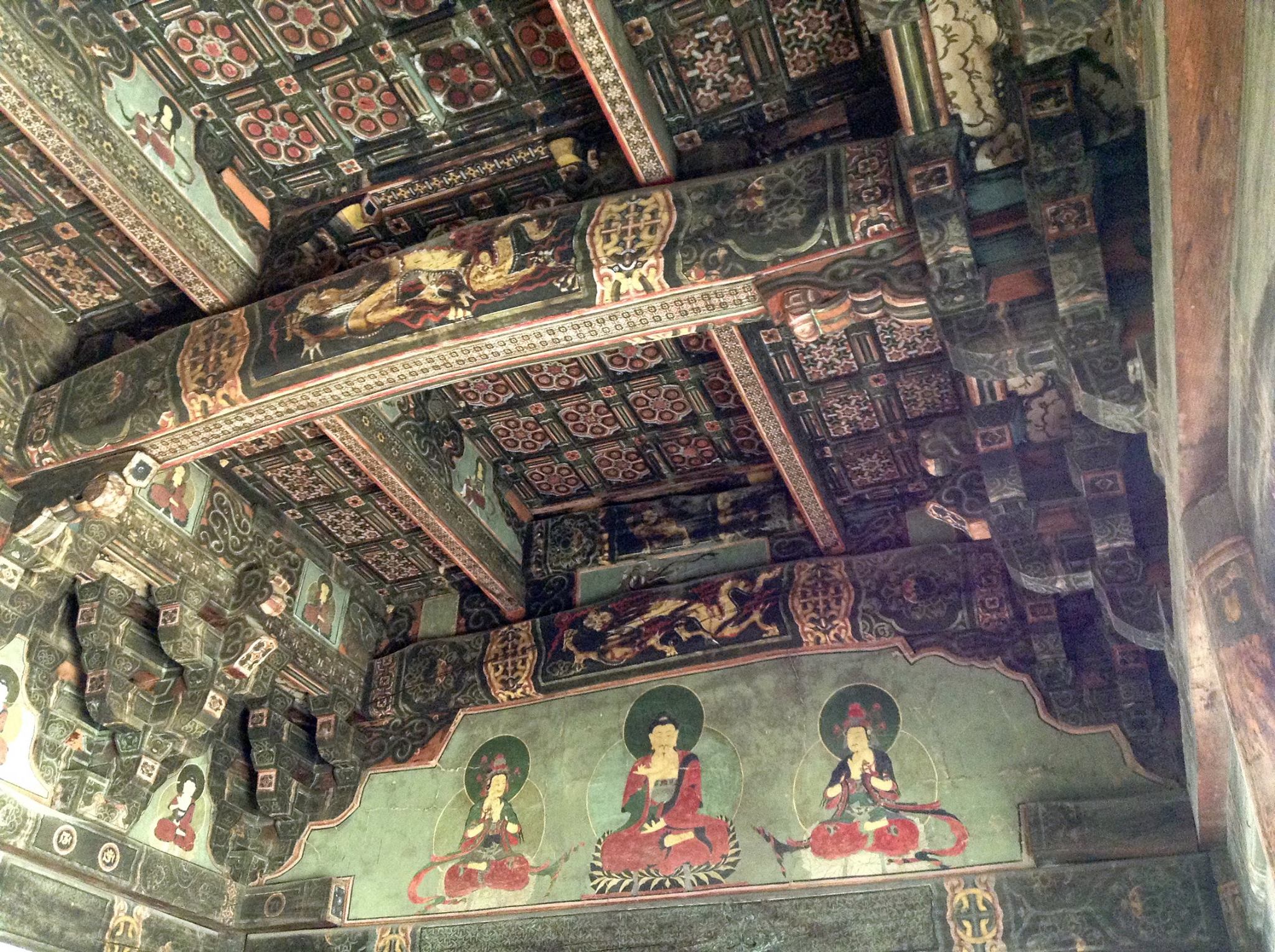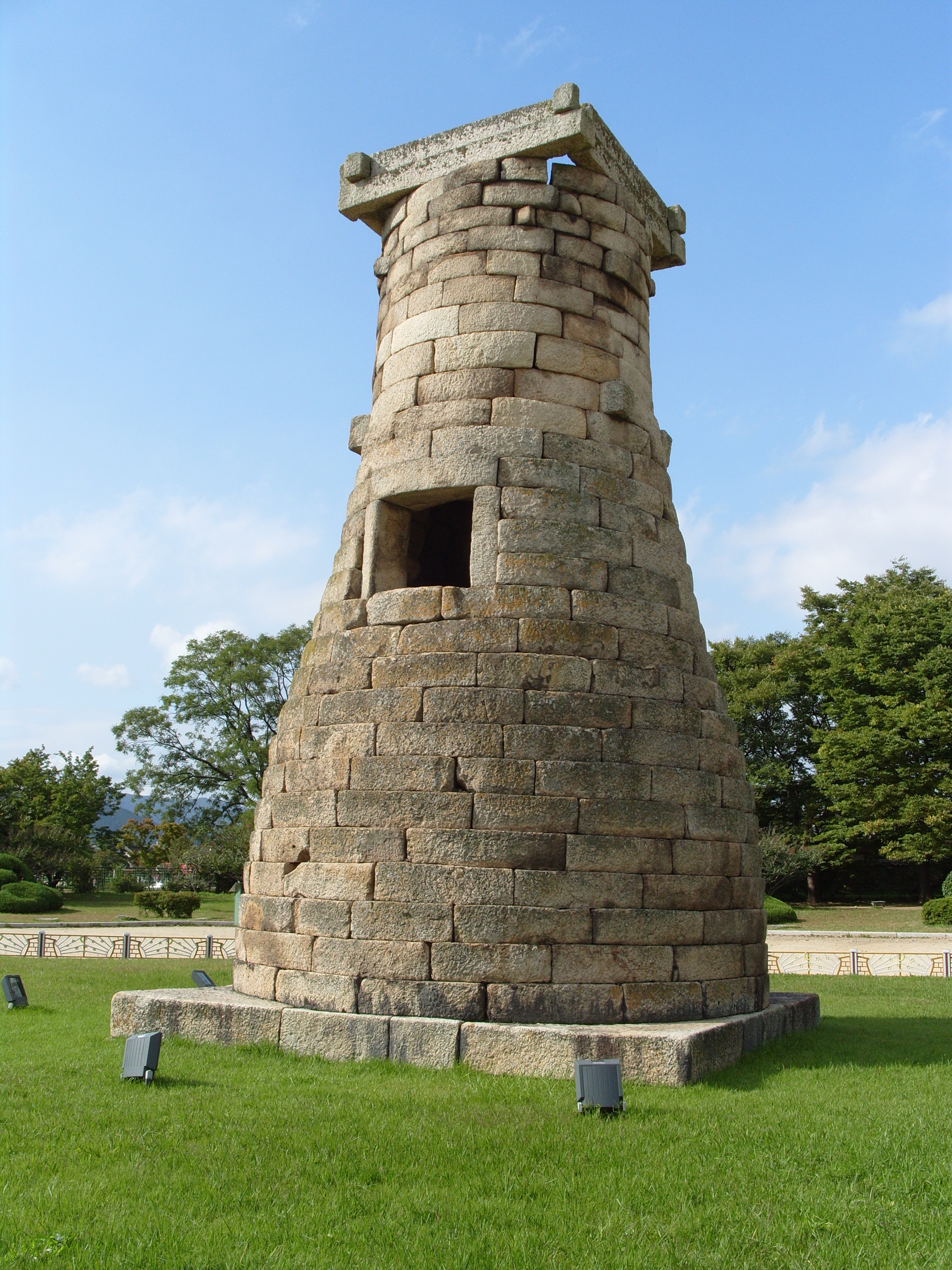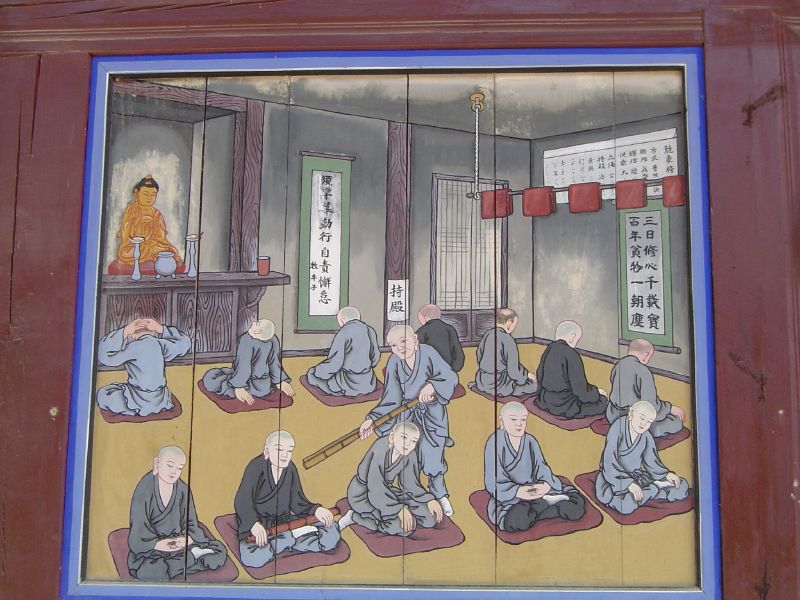|
Tongdosa
Tongdosa (, "Salvation of the World through Mastery of Truth")Le Bas, Tom :"South Korea" pg 244, Insight Guides, 8th edition 2007 is a head temple of the Jogye Order of Korean Buddhism and in the southern part of Mt. Chiseosan near Yangsan, South Gyeongsang Province, South Korea. Tongdosa is one of the Three Jewels Temples and represents Gautama Buddha. (Haeinsa, also in South Gyeongsang Province, represents the dharma or Buddhist teachings; and Songgwangsa in South Jeolla Province represents the sangha or Buddhist community.) Tongdosa is famous because there are no statues outside of the Buddha at the temple because the "real shrines of the Buddha" (relics) are preserved at Tongdosa. Courtyards at the temple are arrayed around several pagodas that house the Buddha's relics. Origins Tongdosa was established by the monk Jajang-yulsa after returning from Tang China in 646 AD, during the reign of Queen Seondeok of Silla. It thrived throughout the Later Silla and Goryeo periods ( ... [...More Info...] [...Related Items...] OR: [Wikipedia] [Google] [Baidu] |
Jajang
Jajang (590–658) was a monk born Kim Seonjong, into the royal Kim family, in the kingdom of Silla. He is credited with founding the temple of Tongdosa in 646 CE, near in what is now Busan, South Korea, and played a significant role in the adoption of Buddhism as the national religion of Silla. His biography is told in the anthology of Korean Buddhism: "Jogye Culture Web", Vol 10. Gyeyul ( and Yul jong 律宗, or Vinaya in Sanskrit) monastic order, founded by Gyeomik for the study and implementation of śīla (yuljang 律藏) the ''"moral discipline"'' or ''""Budhhist ethics"''), was lost after the decline of Baekje. After him, Jajang revived the Gyeyul order and built the Woljeongsa temple in 643 of Jogye Order of Korean Buddhism on the eastern slopes of Odaesan in Pyeongchang County. Jajang was born in Silla as a true bone (jin'gol) aristocrat. In 641 CE, Jajang and his disciple Seungsil traveled to Tang dynasty China where he received bone relic of Buddha's crown, Śa ... [...More Info...] [...Related Items...] OR: [Wikipedia] [Google] [Baidu] |
Three Jewels Temples
The Three Jewels Temples (삼보사찰, Sambosachal) are the three principal Buddhist temples in Korea, each representing one of the Three Jewels of Buddhism, and all located in South Korea. Tongdosa in South Gyeongsang Province represents the Buddha; Haeinsa, also in South Gyeongsang Province, represents the dharma or Buddhist teachings; and Songgwangsa in South Jeolla Province represents the sangha or Buddhist community. In most Korean Buddhist temples, the highest, most important, and often largest building is the Mahavira Hall--the central hall containing statues of the historical Buddha and other important figures. In the Three Jewel Temples, however, the most important buildings are ones that emphasize each temple's particular jewel. Thus, the main hall in Tongdosa opens out onto a stupa which the faithful claim contains relics of the Buddha; Haeinsa has two large buildings holding the ''Tripitaka Koreana''; and Songgwangsa has several prominent buildings dedicated to its ... [...More Info...] [...Related Items...] OR: [Wikipedia] [Google] [Baidu] |
Queen Seondeok Of Silla
Queen Seondeok of Silla ( ko, 선덕여왕 ; 595~610 – 17 February 647/January 8, Lunar Calendar) reigned as Queen Regnant of Silla, one of the Three Kingdoms of Korea, from 632 to 647. She was Silla's twenty-seventh ruler, and its first reigning queen. She was the second female sovereign in recorded East Asian history and encouraged a renaissance in thought, literature, and the arts in Silla. In Samguksagi, Queen Seondeok was described as "generous, benevolent, wise, and smart". According to the Legend of Jigwi, she was even beautiful. Succession to the throne Born Princess Deokman (), Seondeok was the daughter of King Jinpyeong and Queen Maya of Silla. She had two siblings, Princess Cheonmyeong and Princess Seonhwa (although Seonhwa's existence is controversial due to the discovery of evidence in 2009 that points to King Uija's mother as being Queen Sataek and not Seonhwa as indicated by historical records). It is uncertain whether she or Cheonmyeong was the first born, ... [...More Info...] [...Related Items...] OR: [Wikipedia] [Google] [Baidu] |
Songgwangsa
Songgwangsa () translation: Spreading Pine Temple; alternates: Songgwang-sa, or Songgwang Sa, or Songkwangsa; also known as: Piney Expanse Monastery; originally: Gilsangsa), one of the three jewels of Seon Buddhism, is located in South Jeolla Province on Mount Jogye on the Korean Peninsula. Situated approximately away from the sea, it is within the Jogyesan Provincial Park. While founded in 867, it fell into disuse but was re-established in 1190 by Seon master Jinul. Jinul's meditation teachings evolved from this monastery and contributed significantly to the Seon practice that prevails to this day in Korea. Songgwangsa is considered the "jewel" (''Samgharatna'') of the Korean monastic community. Though smaller in size, it is considered as the greatest among the trio of Three Jewels Temples representing “the Buddha, the dharma, and the sangha". The other two of the trio, Tongdosa and Haeinsa, are located in South Gyeongsang Province. This monastery, though under the jurisdic ... [...More Info...] [...Related Items...] OR: [Wikipedia] [Google] [Baidu] |
Yangsan
Yangsan () is a city in Gyeongsangnam-do Province, South Korea. It borders Ulsan to the northeast, Gijang-gun and Geumjeong-gu in Busan to the southeast, Gimhae to the southwest, and Miryang to the northwest. City Hall is located in Nambu-dong, Yangsan-si. Administrative divisions Currently, Yangsan is made up of 1 Eup (administrative division), 4 Myeon (administrative division) and 8 Dong. A city flag Yangsan City means that it will open up as a future city with a bright, hopeful 21st century like magnolia, the flower of the city, and symbolizes Yangsan's strong will to build a first-class mass-production as the center of economy, society and culture in the eastern inland. Attractions *Tongdosa Temple *Naewon Temple *Yangsan Tower *Yangsan Stadium * Eden Valley Ski Resort *Hongryong Falls *Yangsan Wondong Plum Blossom Festival Climate Transportations Railways Yangsan has two stations on the Gyeongbu Line: Mulgeum station (물금역) and Wondong station (원동역). T ... [...More Info...] [...Related Items...] OR: [Wikipedia] [Google] [Baidu] |
Jogye Order
The Jogye Order, officially the Jogye Order of Korean Buddhism (대한불교조계종, 大韓佛敎 曹溪宗), is the representative order of traditional Korean Buddhism with roots that date back 1200 years to the Later Silla National Master Doui, who brought Seon (known as Zen in the West) and the practice taught by the Sixth Patriarch, Huineng, from China around 820 CE. The name of the Order, ''Jogye'', was adopted from the name of the village where Patriarch Huineng's home temple, Nanhua Temple, is located, (). The Jogye as a distinct school arose in the late 11th century when Jinul sought to combine the direct practices of Korean Seon with the theological underpinnings of sutra-based Buddhist schools as well as with Pure Land Buddhism. In 1994, the Jogye order managed 1725 temples, 10,056 clerics and had 9,125,991 adherents. The international Kwan Um School of Zen is a Jogye school founded by Seon Master Seungsahn, 78th Patriarch, who received Dharma transmission from S ... [...More Info...] [...Related Items...] OR: [Wikipedia] [Google] [Baidu] |
South Gyeongsang Province
South Gyeongsang Province ( ko, 경상남도, translit=Gyeongsangnam-do, ) is a province in the southeast of South Korea. The provincial capital is at Changwon. It is adjacent to the major metropolitan center and port of Busan. The UNESCO World Heritage Site Haeinsa, a Buddhist temple that houses the ''Tripitaka Koreana'' and tourist attraction, is located in this province. Automobile and petrochemical factories are largely concentrated along the southern part of the province, extending from Ulsan through Busan, Changwon, and Jinju. Etymology The name derives ; . The name derives from the names of the principal cities of Gyeongju () and Sangju (). History Before 1895, the area corresponding to modern-day South Gyeongsang Province was part of Gyeongsang Province, one of the Eight Provinces of Korea during the Joseon dynastic kingdom. In 1895, southern Gyeongsang was replaced by the districts of Jinju in the west and Dongnae (modern-day Busan) in the east. In 1896, they were ... [...More Info...] [...Related Items...] OR: [Wikipedia] [Google] [Baidu] |
Goryeo
Goryeo (; ) was a Korean kingdom founded in 918, during a time of national division called the Later Three Kingdoms period, that unified and ruled the Korean Peninsula until 1392. Goryeo achieved what has been called a "true national unification" by Korean historians as it not only unified the Later Three Kingdoms but also incorporated much of the ruling class of the northern kingdom of Balhae, who had origins in Goguryeo of the earlier Three Kingdoms of Korea. The name "Korea" is derived from the name of Goryeo, also spelled Koryŏ, which was first used in the early 5th century by Goguryeo. According to Korean historians, it was during the Goryeo period that the individual identities of Goguryeo, Baekje, and Silla were successfully merged into a single entity that became the basis of modern-day 'Korean' identity. Throughout its existence, Goryeo, alongside Unified Silla, was known to be the "Golden Age of Buddhism" in Korea. As the state religion, Buddhism achieved its highes ... [...More Info...] [...Related Items...] OR: [Wikipedia] [Google] [Baidu] |
Cliff
In geography and geology, a cliff is an area of rock which has a general angle defined by the vertical, or nearly vertical. Cliffs are formed by the processes of weathering and erosion, with the effect of gravity. Cliffs are common on coasts, in mountainous areas, escarpments and along rivers. Cliffs are usually composed of rock that is resistant to weathering and erosion. The sedimentary rocks that are most likely to form cliffs include sandstone, limestone, chalk, and dolomite. Igneous rocks such as granite and basalt also often form cliffs. An escarpment (or scarp) is a type of cliff formed by the movement of a geologic fault, a landslide, or sometimes by rock slides or falling rocks which change the differential erosion of the rock layers. Most cliffs have some form of scree slope at their base. In arid areas or under high cliffs, they are generally exposed jumbles of fallen rock. In areas of higher moisture, a soil slope may obscure the talus. Many cliffs also fea ... [...More Info...] [...Related Items...] OR: [Wikipedia] [Google] [Baidu] |
Chinese Characters
Chinese characters () are logograms developed for the writing of Chinese. In addition, they have been adapted to write other East Asian languages, and remain a key component of the Japanese writing system where they are known as ''kanji''. Chinese characters in South Korea, which are known as ''hanja'', retain significant use in Korean academia to study its documents, history, literature and records. Vietnam once used the '' chữ Hán'' and developed chữ Nôm to write Vietnamese before turning to a romanized alphabet. Chinese characters are the oldest continuously used system of writing in the world. By virtue of their widespread current use throughout East Asia and Southeast Asia, as well as their profound historic use throughout the Sinosphere, Chinese characters are among the most widely adopted writing systems in the world by number of users. The total number of Chinese characters ever to appear in a dictionary is in the tens of thousands, though most are graphic ... [...More Info...] [...Related Items...] OR: [Wikipedia] [Google] [Baidu] |
Dragon
A dragon is a reptilian legendary creature that appears in the folklore of many cultures worldwide. Beliefs about dragons vary considerably through regions, but dragons in western cultures since the High Middle Ages have often been depicted as winged, horned, and capable of breathing fire. Dragons in eastern cultures are usually depicted as wingless, four-legged, serpentine creatures with above-average intelligence. Commonalities between dragons' traits are often a hybridization of feline, reptilian and avian features. Scholars believe huge extinct or migrating crocodiles bear the closest resemblance, especially when encountered in forested or swampy areas, and are most likely the template of modern Oriental dragon imagery. Etymology The word ''dragon'' entered the English language in the early 13th century from Old French ''dragon'', which in turn comes from la, draconem (nominative ) meaning "huge serpent, dragon", from Ancient Greek , (genitive , ) "serpent, giant s ... [...More Info...] [...Related Items...] OR: [Wikipedia] [Google] [Baidu] |
Japanese Invasions Of Korea (1592–98)
* Japanese studies
{{disambiguation
Language and nationality disambiguation pages ...
Japanese may refer to: * Something from or related to Japan, an island country in East Asia * Japanese language, spoken mainly in Japan * Japanese people, the ethnic group that identifies with Japan through ancestry or culture ** Japanese diaspora, Japanese emigrants and their descendants around the world * Japanese citizens, nationals of Japan under Japanese nationality law ** Foreign-born Japanese, naturalized citizens of Japan * Japanese writing system, consisting of kanji and kana * Japanese cuisine, the food and food culture of Japan See also * List of Japanese people * * Japonica (other) * Japonicum * Japonicus This list of Latin and Greek words commonly used in systematic names is intended to help those unfamiliar with classical languages to understand and remember the scientific names of organisms. The binomial nomenclature used for animals and plants i ... [...More Info...] [...Related Items...] OR: [Wikipedia] [Google] [Baidu] |






